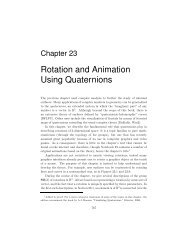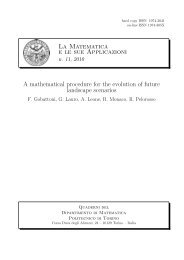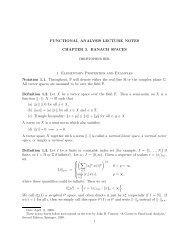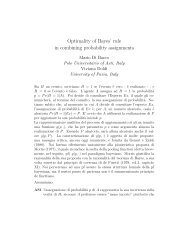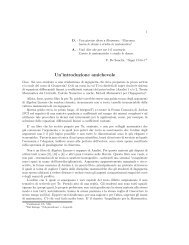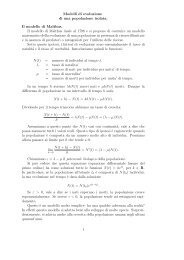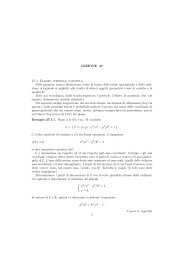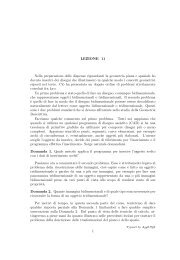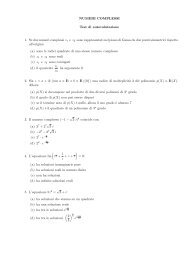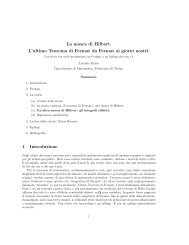INTEGRALI INDEFINITI e DEFINITI Esercizi risolti 1. E' data la ...
INTEGRALI INDEFINITI e DEFINITI Esercizi risolti 1. E' data la ...
INTEGRALI INDEFINITI e DEFINITI Esercizi risolti 1. E' data la ...
You also want an ePaper? Increase the reach of your titles
YUMPU automatically turns print PDFs into web optimized ePapers that Google loves.
12. Data <strong>la</strong> presenza del valore assoluto, distinguiamo le due funzioni che formano <strong>la</strong> prima componente di f(x), sui<br />
due intervalli (−∞, 0) e [0, 1), e riscriviamo<br />
⎧ √<br />
⎪⎨ √<br />
−x se x < 0<br />
f(x) = x se 0 ≤ x < 1<br />
⎪⎩<br />
1<br />
4 + x2 se x ≥ <strong>1.</strong><br />
Iniziamo a trovare tutte le primitive di ciascuna delle tre funzioni che compongono f(x).<br />
<br />
√−x<br />
F1(x) = dx =<br />
<br />
F3(x) =<br />
<br />
√x<br />
F2(x) = dx =<br />
<br />
1 1<br />
dx =<br />
4 + x2 4<br />
(−x) 1/2 dx = − (−x)3/2<br />
3/2 + c1 = − 2<br />
(−x) 3 + c1 , se x < 0.<br />
3<br />
(x) 1/2 dx = (x)3/2<br />
3/2 + c1 = 2√<br />
x3 + c2 , se x ∈ (0, 1).<br />
3<br />
1<br />
1 + x2<br />
4<br />
dx = 1<br />
<br />
2<br />
Le primitive generalizzate devono essere funzioni continue. Dunque deve essere<br />
Pertanto<br />
lim<br />
x→0− F1(x) = lim<br />
x→0 + F2(x) e lim<br />
1/2<br />
1 x<br />
dx = arctan<br />
1 + (x/2) 2 2 2 + c3 , se x > <strong>1.</strong><br />
x→1− F2(x) = lim F3(x).<br />
x→1 +<br />
c1 = c2 e 2<br />
3 + c2 = 1 1<br />
2 arctan 2 + c3, da cui c1 = c2 = c e c3 = c + 2 1 1<br />
3 − 2 arctan 2 .<br />
Dunque tutte le primitive generalizzate di f(x) sono le funzioni<br />
⎧<br />
−<br />
⎪⎨<br />
Fc(x) =<br />
⎪⎩<br />
2<br />
−x3 + c se x < 0<br />
3<br />
2√<br />
x3 + c se 0 ≤ x < 1<br />
3<br />
1 x 2 1 1<br />
arctan + c + − arctan se x ≥ <strong>1.</strong><br />
2 2 3 2 2<br />
Cerchiamo tra esse quel<strong>la</strong> tale che Fc(0) = 0: 0 = 2<br />
3 03/2 + c .<br />
Si ricava dunque c = 0. Pertanto <strong>la</strong> primitiva cercata è <strong>la</strong> funzione<br />
⎧<br />
−<br />
⎪⎨<br />
F (x) =<br />
⎪⎩<br />
2<br />
−x3 se x < 0<br />
3<br />
2√<br />
x3 se 0 ≤ x < 1<br />
3<br />
1 x 2 1 1<br />
arctan + − arctan se x ≥ <strong>1.</strong><br />
2 2 3 2 2



